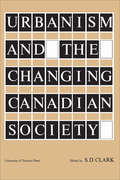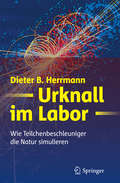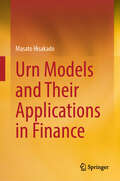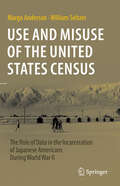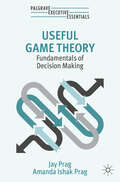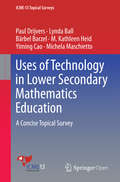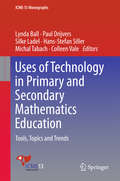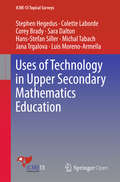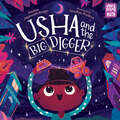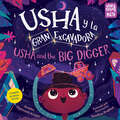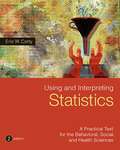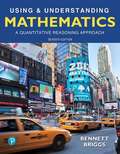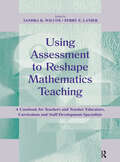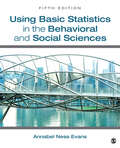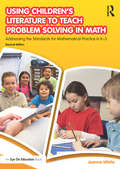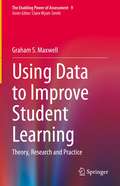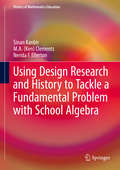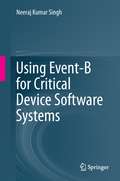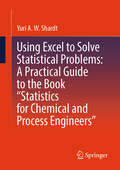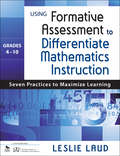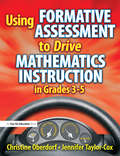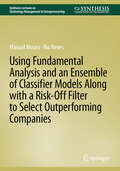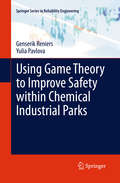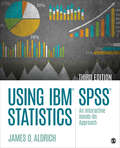- Table View
- List View
Urbanism and the Changing Canadian Society
by S. D. ClarkIn this collection of essays the changing structure of the Canadian community, especially in its urban growth, is brought before the reader with many fresh insights, much vigorous comment, and apt illustration. The authors, concentrating on certain kinds of problems which have interested them individually, provide for student and general reader stimulating analysis of social phenomena which are under lively examination these days in Canada and beyond both in popular and semi-popular journals and magazines and in learned writings.Nathan Keyfitz opens the volume with a valuable background analysis of the way in which the population of Canada has reached its present numbers and distribution and examines the effects of immigration and of changing rates of birth and death. S.D. Clark deals with the controversial question of what the real characteristics of the suburban community can be seen to be and comments forcefully on the "suburbia" of Riesman, Whyte, et al. W.E. Mann presents a fascinating analysis of the patterns of life in a slum area of Toronto which swarms with factory workers and truck-drivers, with people of many racial origins, and which has developed social habits based largely on rooming-houses, small shops, and pubs. Jean Burnet provides an historical account of changing moral standards of sobriety and piety as reflected in sabbatarian and temperance movements in Toronto, long regarded as the quintessence of severity. Oswald Hall gives a valuable analysis of the patterns of growth in the professions and of the kinds of competitive struggles going on within them and at the borders between them as new groups strive to win this status in society. P.J. Giffen takes up an important related question of how interests of a self-governing profession relate to the expectations of the public and uses the legal profession as his example. Finally, Leo Zakuta adds to the scanty literature on Canadian political parties an analysis of the changing character of the C.C.F., long the dominant force in left-of-centre politics.The authors all are, or have been members of the staff in sociology at the University of Toronto, and their essays convey an excellent picture of the liveliness of the work they jointly carry forward. This volume will thus serve not only to introduce students to some of the kinds of problems sociologists are thinking about but will also make better known to them as a group some of the sociologists in Canada who are engaged with them.
Urknall im Labor
by Dieter B. HerrmannDie Frage nach der Herkunft, Entwicklung und Zukunft des Universums zählt zu den großen wissenschaftlichen Themen der Gegenwart. Kernphysiker und Astrophysiker gehen dieser Frage heute mithilfe moderner Teilchenbeschleuniger nach, die kosmische Extremzustände förmlich nachahmen können. Sie hoffen, dadurch dem Verständnis der Lebensgeschichte des Universums ein großes Stück näher zu kommen. Allgemein verständlich und unterhaltsam beschreibt der Autor dieses große Abenteuer der Forschung, das vor 400 Jahren mit den ersten Fernrohren Galileis begann.
Urn Models and Their Applications in Finance
by Masato HisakadoThis fascinating book begins with fundamental definitions and notations of urn models before moving on to stochastic processes and applications of urn models in the field of finance. The Pólya urn model is simple but has rich content and diverse applications because it includes correlations. Applications of Pólya models such as phase transitions in nonlinear Pólya models are studied here, and the relation between temporal correlation and phase transition is also discussed. In a continuous limit, the self-exciting negative binomial distribution model and Hawkes model, which has Poisson noise, can be obtained. In these models, it is possible to observe phase transition as a branching process, which is one of the absorption phase transitions. If connected urns are considered, the process can be extended to represent correlations between several urns, corresponding to complex networks among the urns and leading to consideration of how the network affects the urn processes. In this book, the method is applied to default portfolios, including correlations. In finance, correlation is an important issue in the clustering of a default, and several topics involving applications of urn models to risk assessment for default portfolios in finance are explained. Especially in default portfolios, some sectors affect many other sectors while other sectors do not; thus the origin of default contagion, a phenomenon to which urn models with networks are applied here.
Use and Misuse of the United States Census: The Role of Data in the Incarceration of Japanese Americans During World War II
by Margo Anderson William SeltzerThe U.S. government conducts a population census every 10 years, adds up the counts by geographic location, and uses the resulting numbers in formulas to allocate seats in the House of Representative and Electoral College, and to make public funding and tax decisions. It has served as an essential tool of representative democracy since 1790. The raw data from the census also serve as a decennial snapshot of the nation, a very long list, organized by household, ideally of all people resident on census day, with additional information on the name, age, race, sex, geographic location, and other characteristics for each individual. Americans recognized early in their history that the raw data, the list, could serve additional governmental functions, and over the centuries, erected guardrails to prevent improper use. They are encapsulated in the presidential proclamations announcing the upcoming census. The information collected from individual households is for aggregated use only, and cannot be used for the “taxation, regulation, or investigation” of individual persons or businesses. Americans have heeded the call to “stand up and be counted.” They also engage in an ongoing conversation to make sure that the information is used properly and ethically, that the census serves as a tool of representative democracy and advances the rights – including human rights -- of all Americans. The record, however, reveals that there have been failures to meet this goal and that as a result the information provided by the responding public sometimes has been misused, causing considerable harm to vulnerable individuals, groups and entities. Today, as governments and social media are suspect for their exploitation of data about individuals, the experience of Americans of Japanese ancestry in the United States during World War II provides a chilling example of such misuse of census data. This book reveals how census officials stepped beyond their normal roles as unobtrusive monitors of American demographic life and helped justify and administer the relocation and incarceration program. Census officials mobilized the substantial administrative and technical resources of the 1940 census, to map the neighbourhoods where Japanese-Americans lived, and planned their systematic removal. The officials then built “census-like” data systems to track the “evacuees” for the duration of the war, monitor their lives in the camps, and certify which “loyal” evacuees might be released from the camps for military or civilian service. After the war, census officials drafted an official history of their activities, but did not publish it. This book has lessons for policy makers and ordinary Americans alike, as we confront the new digital world in which we live. And it speaks to two of the great issues of our time: distrust in the institutions of government and the victimization of minorities.
Useful Game Theory: Fundamentals of Decision Making (Palgrave Executive Essentials)
by Jay Prag Amanda Ishak PragUseful Game Theory offers a refreshing perspective on modern wisdom, empowering readers to master strategic decision-making with the tools they already possess. Every decision you make involves an element of game theory, often without you even realizing it. In this insightful book, economist Jay Prag and marketing strategist Amanda Ishak Prag delve into the essence of human nature, transforming the mathematical principles of game theory into practical, everyday strategies. Through familiar proverbs and timeless wisdom, readers will explore how elements like reputation, biases, cooperation, and family dynamics influence our strategic interactions. From navigating a four-way stop and choosing take-out dinners to understanding the complexities of nuclear disarmament, Useful Game Theory demonstrates how recognizing the structure of games—players, choices, and outcomes—can enhance decision-making in all aspects of life.
Uses of Technology in Lower Secondary Mathematics Education
by Paul Drijvers Lynda Ball Bärbel Barzel M. Kathleen Heid Yiming Cao Michela MaschiettoThis topical survey provides an overview of the current state of the art in technology use in mathematics education, including both practice-oriented experiences and research-based evidence, as seen from an international perspective. Three core themes are discussed: Evidence of effectiveness; Digital assessment; and Communication and collaboration. The survey s final section offers suggestions for future trends in technology-rich mathematics education and provides a research agenda reflecting those trends. Predicting what lower secondary mathematics education might look like in 2025 with respect to the role of digital tools in curricula, teaching and learning, it examines the question of how teachers can integrate physical and virtual experiences to promote a deeper understanding of mathematics. The issues and findings presented here provide an overview of current research and offer a glimpse into a potential future characterized by the effective integration of technology to support mathematics teaching and learning at the lower secondary level. "
Uses of Technology in Primary and Secondary Mathematics Education: Tools, Topics And Trends (ICME-13 Monographs)
by Paul Drijvers Lynda Ball Hans-Stefan Siller Silke Ladel Michal Tabach Colleen ValeThis book provides international perspectives on the use of digital technologies in primary, lower secondary and upper secondary school mathematics. It gathers contributions by the members of three topic study groups from the 13th International Congress on Mathematical Education and covers a range of themes that will appeal to researchers and practitioners alike. The chapters include studies on technologies such as virtual manipulatives, apps, custom-built assessment tools, dynamic geometry, computer algebra systems and communication tools. Chiefly focusing on teaching and learning mathematics, the book also includes two chapters that address the evidence for technologies’ effects on school mathematics. The diverse technologies considered provide a broad overview of the potential that digital solutions hold in connection with teaching and learning. The chapters provide both a snapshot of the status quo of technologies in school mathematics, and outline how they might impact school mathematics ten to twenty years from now.
Uses of Technology in Upper Secondary Mathematics Education
by Hans-Stefan Siller Stephen Hegedus Colette Laborde Corey Brady Sara Dalton Michal Tabach Jana Trgalova Luis Moreno-ArmellaThis survey addresses the use of technology in upper secondary mathematics education from four points of view: theoretical analysis of epistemological and cognitive aspects of activity in new technology mediated learning environments, the changes brought by technology in the interactions between environment, students and teachers, the interrelations between mathematical activities and technology, skills and competencies that must be developed in teacher education. Research shows that the use of some technologies may deeply change the solving processes and contribute to impact the learning processes. The questions are which technologies to choose for which purposes, and how to integrate them, so as to maximize all students' agency. In particular the role of the teacher in classrooms and the content of teacher education programs are critical for taking full advantage of technology in teaching practice.
Usha and the Big Digger (Storytelling Math)
by Amitha Jagannath KnightCelebrate diversity, math, and the power of storytelling!When sisters Usha and Aarti look up at the stars, they see different things. Aarti sees the Big Dipper, but Usha sees the Big DIGGER. And cousin Gloria sees the Big Kite! Could they all be right? A playful introduction to geometry and spatial relationships, featuring Indian American characters and a note about cultures and constellations.Storytelling Math celebrates children using math in their daily adventures as they play, build, and discover the world around them. Joyful stories and hands-on activities make it easy for kids and their grown-ups to explore everyday math together. Developed in collaboration with math experts at STEM education nonprofit TERC, under a grant from the Heising-Simons Foundation.
Usha y la Gran Excavadora / Usha and the Big Digger (Storytelling Math)
by Amitha Jagannath KnightCelebrate diversity, math, and the power of storytelling! ¡Celebremos la diversidad, las matemáticas y el poder del cuento!Now in a Spanish bilingual edition! When sisters Usha and Aarti look up at the stars, they see different things. Aarti sees the Big Dipper, but Usha sees the Big DIGGER. And cousin Gloria sees the Big Kite! Could they all be right? A playful introduction to geometry and spatial relationships, featuring Indian American characters and a note about cultures and constellations. Storytelling Math celebrates children using math in their daily adventures as they play, build, and discover the world around them. Joyful stories and hands-on activities make it easy for kids and their grown-ups to explore everyday math together. Developed in collaboration with math experts at STEM education nonprofit TERC, under a grant from the Heising-Simons Foundation. ¡Ahora en edición bilingüe inglés-español! Al observar las estrellas, las hermanas Usha y Aarti ven diferentes cosas. Aarti ve el Gran Cazo y Usha ve la Gran EXCAVADORA. ¡Gloria, su prima, ve la Gran Cometa! ¿Puede ser que todas tengan razón? Este cuento es una introducción entretenida a la geometría y las relaciones espaciales, con personajes indios americanos y una nota sobre culturas y constelaciones. Los libros de la serie Cuentos matemáticos celebran las aventuras diarias de niños que usan las matemáticas mientras juegan, construyen y descubren el mundo que los rodea. Historias divertidas y actividades prácticas facilitan que tanto los niños como los adultos exploren juntos las matemáticas de la vida diaria. Fue desarrollada junto a expertos en el currículum STEM, pertenecientes a TERC Inc., organización sin fines de lucro, bajo una subvención otorgada por Heising-Simons Foundation.
Using & Interpreting Statistics: A Practical Text for the Behavioral, Social, and Health Sciences,2nd Edition
by Eric W. CortyEric Corty’s engaging, easy-to-understand textbook focuses on the needs of behavioral science students encountering statistical practices for the first time. An award-winning master teacher, Corty speaks to students in their language, with an approachable voice that conveys the basics of statistics step-by-step. Examples come from the behavioral and social sciences, as well as from recognizable aspects of everyday life to help students see the relevance of statistics.
Using And Understanding Mathematics: A Quantitative Reasoning Approach
by Jeffrey O. Bennett William L. BriggsThe standard in quantitative reasoning instruction – by authorities in the field <P><P> The 7th Edition of Using & Understanding Mathematics by Jeff Bennett and Bill Briggs aims to prepare students for the mathematics they will encounter in other college courses, future careers, and life. <P><P> The authors' goal is to develop students’ ability to reason with quantitative information in a way that will help achieve success in their careers, and to give students the critical-thinking and quantitative reasoning skills needed to understand major life issues. Through new resources in MyLab™ Math and updated content within the text, the Bennett/Briggs team continues to set the standard in quantitative reasoning instruction.
Using Assessment To Reshape Mathematics Teaching: A Casebook for Teachers and Teacher Educators, Curriculum and Staff Development Specialists (Studies in Mathematical Thinking and Learning Series)
by Sandra K. Wilcox Perry E. LanierThis casebook is intended to support professionals who are working in a variety of contexts to use classroom-based assessment more effectively to support teacher learning and teaching change, and to enhance the opportunities for all students to develop mathematical power. It grows out of a collaboration of mathematics teachers and teacher educators, and mathematicians, to better understand the role of assessment as an ongoing activity to help teachers reshape their own teaching practices. At the heart of each case is using assessment to make sense of what students understand and what they are confused about, deciding what counts as evidence of that understanding, and using the analysis to consider what the teacher's next instructional moves might be. All of the cases in this volume are built around actual episodes from mathematics classrooms. Intended as decision-making exercises, they present the raw data of classroom events in a straightforward way and are designed to stimulate analysis and reflection; provoke various and sometimes conflicting interpretations of an event; bring to the fore deeply held beliefs of beginning and experienced teachers so they can be reconsidered; and engage professionals in pedagogical problem solving in the context of complex classroom settings. This volume reflects the growing interest in cases as a pedagogical tool in teacher professional development. The cases are organized to take up key themes of the NCTM Professional Teaching Standards in ways that will assist and support teachers, teacher educators, and curriculum and staff development specialists in learning to assess and in linking assessment with curriculum, teaching, and learning. Although each case contains many ideas for linking assessment with curriculum and instruction, the most powerful use of these materials resides in their design intended to foster conversations among groups of professional colleagues. The editors' field-testing of the cases--in initial teacher certification courses and in in-service workshops--has shown that they prompt engaging and demanding analysis through a variety of analytic lenses. A videotape containing vignettes for four of the cases in the Casebook is available with this book. Transcriptions of the video vignettes are printed in the case materials in the book. Course instructors and professional development facilitators will need both the Casebook and the videotape and should order the Casebook/Video set. The video can also be ordered separately.
Using Basic Statistics in the Behavioral and Social Sciences
by Annabel Ness EvansUsing Basic Statistics in the Behavioral and Social Sciences, Fifth Edition, by Annabel Ness Evans, presents introductory statistics in a practical, conceptual, and humorous way, reducing the anxiety that many students experience in introductory courses. Avoiding complex notation and derivation, the book focuses on helping readers develop an understanding of the underlying logic of statistics. Practical Focus on Research boxes engage students with realistic applications of statistics, and end-of-chapter exercises ensure student comprehension. This exciting new edition includes a greater number of realistic and engaging global examples within the social and behavioral sciences, making it ideal for use within many departments or in interdisciplinary settings.
Using Children's Literature to Teach Problem Solving in Math: Addressing the Standards for Mathematical Practice in K–5
by Jeanne WhiteLearn how children’s literature can help K–5 students see the real-life applications of mathematical concepts. This user-friendly book shows how to use stories to engage students in building critical reasoning, abstract thinking, and communication skills, all while helping students understand the relevance of math in their everyday lives. Each chapter is dedicated to one of the eight Standards for Mathematical Practice, and offers examples of children’s literature that can be used to help students develop that practice. You’ll find out how to: Encourage students to persevere in solving mathematical problems and use multiple approaches to find the answer; Help students reason abstractly with the aid of concrete objects and visuals; Guide students in constructing arguments to explain their reasoning and engage in critical discussion with their peers; Teach students to recognize mathematical patterns and use them to solve problems efficiently; And more! The book offers activities for beginners as well as for more advanced problem solvers. Each chapter also provides guidance for ELLs and students with special needs, so no matter your classroom environment, you’ll be able to use these strategies to make math class more dynamic, engaging, and fun.
Using Data to Improve Student Learning: Theory, Research and Practice (The Enabling Power of Assessment #9)
by Graham S. MaxwellThis book offers a coherent research-based overview and analysis of theories and practices in using data to improve student learning. It clarifies what 'use of data' means and differentiates the different levels of decision-making in education (relating to the system, district, school, classroom, or individual student). The relationship between data and decision-making is considered and various movements in the use of data to improve student learning are analysed, especially from the perspective of their assumptions and effects. This leads to a focus on effective educational decision-making as a social process requiring collaboration among all relevant participants. It also requires a clear understanding of educational aims, and these are seen to transcend what can be assessed by standardised tests. The consequences of this analysis for decision processes are explored and conclusions are drawn about what principles might best guide educational practice as well as what ambiguities remain. Throughout, the focus is on what existing research says about each of the issues explored.
Using Design Research and History to Tackle a Fundamental Problem with School Algebra
by M. A. Ken Clements Nerida F. Ellerton Sinan KanbirIn this well-illustrated book the authors, Sinan Kanbir, Ken Clements, and Nerida Ellerton, tackle a persistent, and universal, problem in school mathematics--why do so many middle-school and secondary-school students find it difficult to learn algebra well? What makes the book important are the unique features which comprise the design-research approach that the authors adopted in seeking a solution to the problem. The first unique feature is that the authors offer an overview of the history of school algebra. Despite the fact that algebra has been an important component of secondary-school mathematics for more than three centuries, there has never been a comprehensive historical analysis of factors influencing the teaching and learning of that component. The authors identify, through historical analysis, six purposes of school algebra: (a) algebra as a body of knowledge essential to higher mathematical and scientific studies, (b) algebra as generalized arithmetic, (c) algebra as a prerequisite for entry to higher studies, (d) algebra as offering a language and set of procedures for modeling real-life problems, (e) algebra as an aid to describing structural properties in elementary mathematics, and (f) algebra as a study of variables. They also raise the question whether school algebra represents a unidimensional trait. Kanbir, Clements and Ellerton offer an unusual hybrid theoretical framework for their intervention study (by which seventh-grade students signifi cantly improved their elementary algebra knowledge and skills). Their theoretical frame combined Charles Sanders Peirce's triadic signifier-interpretant-signified theory, which is in the realm of semiotics, with Johann Friedrich Herbart's theory of apperception, and Ken Clements' and Gina Del Campo's theory relating to the need to expand modes of communications in mathematics classrooms so that students engage in receptive and expressive modes. Practicing classroom teachers formed part of the research team. This book appears in Springer's series on the "History of Mathematics Education. " Not only does it include an important analysis of the history of school algebra, but it also adopts a theoretical frame which relies more on "theories from the past," than on contemporary theories in the field of mathematics education. The results of the well-designed classroom intervention are sufficiently impressive that the study might have created and illuminated a pathway for future researchers to take.
Using Event-B for Critical Device Software Systems
by Neeraj Kumar SinghDefining a new development life-cycle methodology, together with a set of associated techniques and tools to develop highly critical systems using formal techniques, this book adopts a rigorous safety assessment approach explored via several layers (from requirements analysis to automatic source code generation). This is assessed and evaluated via a standard case study: the cardiac pacemaker. Additionally a formalisation of an Electrocardiogram (ECG) is used to identify anomalies in order to improve existing medical protocols. This allows the key issue - that formal methods are not currently integrated into established critical systems development processes - to be discussed in a highly effective and informative way. Using Event-B for Critical Device Software Systems serves as a valuable resource for researchers and students of formal methods. The assessment of critical systems development is applicable to all industries, but engineers and physicians from the health domain will find the cardiac pacemaker case study of particular value.
Using Excel to Solve Statistical Problems: A Practical Guide to the Book “Statistics for Chemical and Process Engineers”
by Yuri A.W. ShardtThis book provides a complete overview of how to use Excel to solve typical statistical problems in engineering. In addition to short sections on the required theory, the focus of the book is on detailed Excel examples for solving specific problems. Furthermore, solutions are provided for standard problems that can then be re-used and modified as necessary. End-of-chapter questions allow the reader to independently test the knowledge acquired.
Using Formative Assessment to Differentiate Mathematics Instruction, Grades 4–10: Seven Practices to Maximize Learning
by Leslie E. LaudSeven easy steps to differentiating math instruction for busy teachers Staff development expert Leslie Laud provides a clear roadmap for using formative assessment to differentiate mathematics instruction for students in Grades 4–10. She presents a comprehensive framework of seven research-based practices that show teachers how to: Get started and establish norms Implement formative assessment Create tiered lessons Manage a multitasking classroom effectively Tested, reviewed, and enhanced by experienced math teachers, the book includes practical examples, reproducibles, and student activities that are easy for busy teachers to implement immediately.
Using Formative Assessment to Drive Mathematics Instruction in Grades 3-5
by Jennifer Taylor-Cox Christine OberdorfProvide targeted mathematics instruction for every child. These books combine formative assessment with practical activities to differentiate the elementary classroom. The formative assessments include student work samples at varying levels. The authors... Illustrate the distinction between a "traditional" assessment and an "enhanced" assessment. Describe specific differentiated activities so each student may consistently receive instruction geared to specific need. Provide teachers with "Questions to Assess" to determine what each child understands about the math concept. Show how to move students to higher-level mathematics thinking and to apply math concepts. Include extension activities to offer challenging work for children who have achieved skill mastery level. Each activity states a goal, the materials needed, a description of the activity, as well as specific questions to ask students. The assessments and activities are aligned with the Common Core State Standards for Mathematics and the expectations described by the National Council of Teachers of Mathematics.This resource will help teachers, principals, and curriculum directors identify students' levels of understanding about mathematics and provide concrete resources for remediation, instruction, and enrichment. These books are also an excellent resource for use during workshops and in-class observations.
Using Fundamental Analysis and an Ensemble of Classifier Models Along with a Risk-Off Filter to Select Outperforming Companies (Synthesis Lectures on Technology Management & Entrepreneurship)
by Rui Neves Manuel MouraThis book develops a quantitative stock market investment methodology using financial indicators that beats the benchmark of S&P500 index. To achieve this goal, an ensemble of machine learning models is meticulously constructed, incorporating four distinct algorithms: support vector machine, k-nearest neighbors, random forest, and logistic regression. These models all make use of financial ratios extracted from company financial statements for the purposes of predictive forecasting. The ensemble classifier is subject to a strict testing of precision which compares it to the performance of its constituent models separately. Rolling window and cross-validation tests are used in this evaluation in order to provide a comprehensive assessment framework. A risk-off filter is developed to limit risk during uncertain market periods, and consequently to improve the Sharpe ratio of the model. The risk adjusted performance of the final model, supported by the risk-off filter, achieves a Sharpe ratio of 1.63 which surpasses both the model’s performance without the filter that delivers Sharpe ratio of 1.41 and the one from the S&P500 index of 0.80. The substantial increase in risk-adjusted returns is accomplished by reducing the model’s volatility from an annual standard of deviation of 15.75% to 11.22%, which represents an almost 30% decrease in volatility.
Using Game Theory to Improve Safety within Chemical Industrial Parks
by Genserik Reniers Yulia PavlovaThough the game-theoretic approach has been vastly studied and utilized in relation to economics of industrial organizations, it has hardly been used to tackle safety management in multi-plant chemical industrial settings. Using Game Theory for Improving Safety within Chemical Industrial Parks presents an in-depth discussion of game-theoretic modeling which may be applied to improve cross-company prevention and -safety management in a chemical industrial park. By systematically analyzing game-theoretic models and approaches in relation to managing safety in chemical industrial parks, Using Game Theory for Improving Safety within Chemical Industrial Parks explores the ways game theory can predict the outcome of complex strategic investment decision making processes involving several adjacent chemical plants. A number of game-theoretic decision models are discussed to provide strategic tools for decision-making situations. Offering clear and straightforward explanations of methodologies, Using Game Theory for Improving Safety within Chemical Industrial Parks provides managers and management teams with approaches to asses situations and to improve strategic safety- and prevention arrangements.
Using IBM SPSS Statistics: An Interactive Hands-On Approach
by James O. AldrichNow with a new companion website! Using IBM® SPSS® Statistics: An Interactive Hands-On Approach, Third Edition gives readers an accessible and comprehensive guide to walking through SPSS®, providing them with step-by-step knowledge for effectively analyzing their data. From entering data to working with existing databases, and working with the help menu through performing factor analysis, Using IBM® SPSS® Statistics covers every aspect of SPSS® from introductory through intermediate statistics. The book is divided into parts that focus on mastering SPSS® basics, dealing with univariate statistics and graphing, inferential statistics, relational statistics, and more. Written using IBM® SPSS® version 25 and 24, and compatible with the earlier releases, this book is one of the most comprehensive SPSS® guides available. Bundle Using IBM® SPSS® Statistics: An Interactive Hands-On Approach with SAGE IBM® SPSS® Statistics v24.0 Student Version and SAVE! – Bundle ISBN: 978-1-5443-5071-4
Using IBM SPSS Statistics: An Interactive Hands-On Approach
by James O. AldrichNow with a new companion website! Using IBM® SPSS® Statistics: An Interactive Hands-On Approach, Third Edition gives readers an accessible and comprehensive guide to walking through SPSS®, providing them with step-by-step knowledge for effectively analyzing their data. From entering data to working with existing databases, and working with the help menu through performing factor analysis, Using IBM® SPSS® Statistics covers every aspect of SPSS® from introductory through intermediate statistics. The book is divided into parts that focus on mastering SPSS® basics, dealing with univariate statistics and graphing, inferential statistics, relational statistics, and more. Written using IBM® SPSS® version 25 and 24, and compatible with the earlier releases, this book is one of the most comprehensive SPSS® guides available. Bundle Using IBM® SPSS® Statistics: An Interactive Hands-On Approach with SAGE IBM® SPSS® Statistics v24.0 Student Version and SAVE! – Bundle ISBN: 978-1-5443-5071-4
